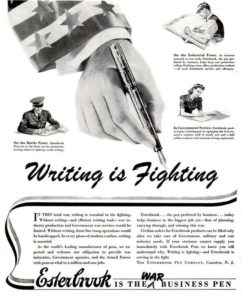 The things we underestimate today. It never occurred to me until recently when my friend and mentor, David Wojdyla, asked me, “Did you ever wonder why none of these letters were composed with a ballpoint pen?” Truly, I didn’t. I never made the association to the small box of well-used Wearever fountain pens in my grandfather’s desk. Was the fountain pen the writing implement of choice?
The things we underestimate today. It never occurred to me until recently when my friend and mentor, David Wojdyla, asked me, “Did you ever wonder why none of these letters were composed with a ballpoint pen?” Truly, I didn’t. I never made the association to the small box of well-used Wearever fountain pens in my grandfather’s desk. Was the fountain pen the writing implement of choice?
In reality, an American lawyer and leather expert named John Loud initially patented the ballpoint pen in 1888. However, his thought never went any further.
Ballpoint pens didn’t show up in the United States until directly after World War II. Two of the early ballpoint pens of 1945 were the Reynolds Rocket and the Eversharp, both with design flaws. In December of 1950, the BIC ballpoint was brought out. It was quite affordable and became a popular seller.
Fountain pens or pencils were the composition executors during World War II. Administrative staff and officers, not on the battlefronts would have use of a typewriter. Fighters in the field discovered pencils advantageous to convey messages, but pencil lead was often less readable than ink and smeared. A decent fountain pen was profoundly prized, particularly for journal and letter composition.
In the event that you were from an allied nation, chances were you had an Esterbrook, Parker, Sheaffer or Waterman on the off chance that you are in Canada or the US. The UK and whatever remained of the English Province would have the Parker and Waterman alongside English brands like Swan, Conway Stewart, and others.
Fountain pens during the war years were very scarce, as most pen creators would have changed over to war generation materials. Pens like the Parker 51 were in restricted supply.
Top name brands like Parker, Sheaffer, Waterman and Wahl-Eversharp would just have been accessible to officers with a few means, or whose families put it all out there to get them a quality pen. In the beginning of 1942, 88% of the fountain pens made in the United States had steel nibs and were what we would call second or third level pens. A Wearever, Esterbrook or one of the limitless third-level brands out there may have been more likely for the normal fighter.
Sheaffer and Parker routinely competed as being the best fountain pen manufacturers from the 1920s through the 1960s. However, another brand beat them out on sales volume: Wearever. Despite being a second or third–tier pen manufacturer, Wearever sold an enormous amount of pens, especially in the 1940s and ’50s. Design appearance and cost being the major reasons.
World War II grasped the utilization of the fountain pen as it more than filled their need of letter composing. The fountain pen succeeded the dip pen. The dip pen utilized more ink and in this manner, there was the development of the fountain pen that had a repository to store the ink. There was an elastic seal at the top, and to compose there was a nob through which the ink streamed. Those utilizing the fountain pen could top off the repository with ink as required. The pens were pleasing to use in composing letters and were acknowledged by the general public as a way to convey news during the war. The way the fountain pen connected with the paper made it ideal for letter composing.
In 1941, the China Burma India (CBI) Theater was formed by the United States and Allied Land Forces to offer support to China in its war with Japan. It contained the military power that controlled the war in Southeast Asia. The theater had difficulty acquiring fountain pens because they were not promptly accessible to China. At times the theater turned to purchasing the pens for upwards of $15.00 a piece.
After the war, fountain pens were kept in galleries and museums in the United States, China, England, and Germany as a kind of perspective of World War II and to remind the general population what earned the fountain pen their considerable recognition, the ability to compose letters well.